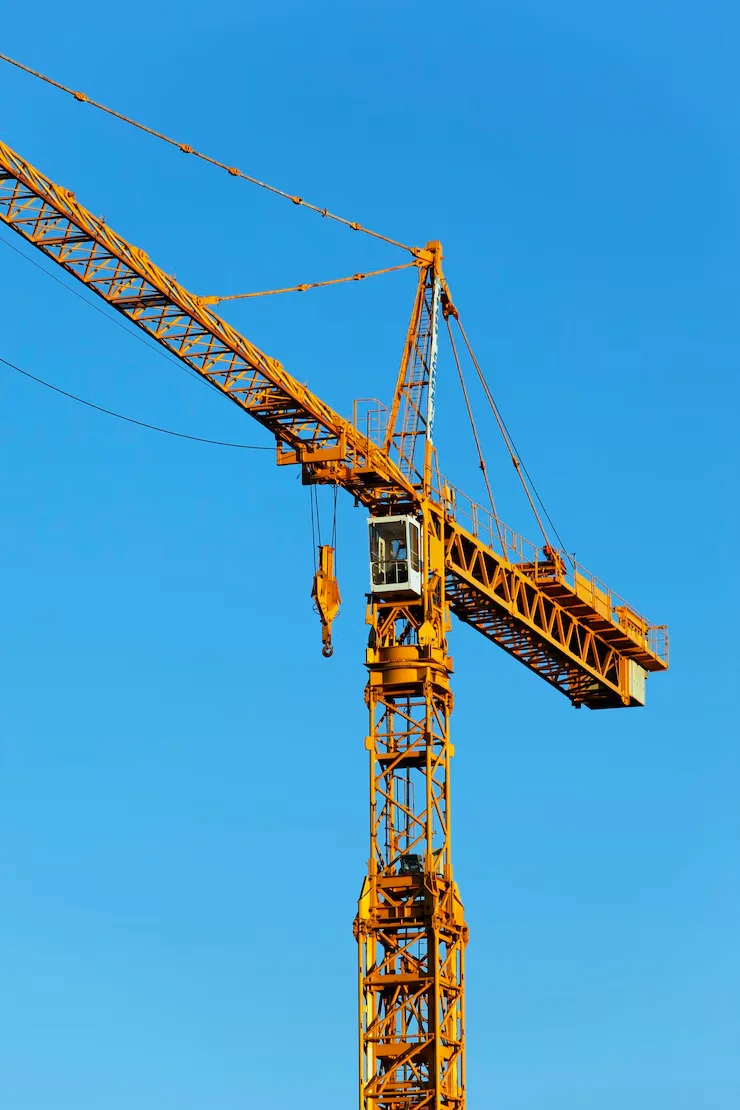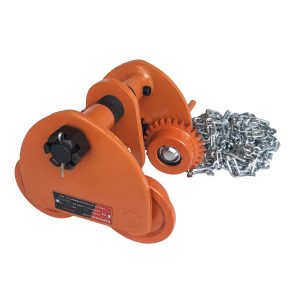Introduction
In material handling operations, beam trolleys are indispensable devices that allow hoists to travel horizontally along an overhead I-beam or similar structure. They form the connection between the lifting hoist and the supporting beam, providing the essential mobility to position loads safely and efficiently. Depending on the requirements of a workplace, operators typically choose between three main types of beam trolleys: plain (push) trolleys, geared trolleys, and motorized trolleys.
While all three serve the same fundamental purpose—supporting and guiding a hoist along a beam—their designs, operating mechanisms, performance characteristics, and safety implications vary considerably. Understanding these differences is crucial in selecting the right equipment for specific applications and ensuring both efficiency and safety in lifting operations. This discussion will compare geared beam trolleys with plain and motorized trolleys, highlighting design distinctions and exploring their implications on performance and safety across industries.
Overview of Beam Trolley Types
1. Plain (Push) Beam Trolleys
A plain or push beam trolley consists of a simple wheeled carriage that rolls freely along the flange of the beam. The operator moves the trolley manually by pushing or pulling the attached hoist and load. These are the most basic and cost-effective type of trolley, relying on operator effort for mobility.
Key traits:
-
Low cost and lightweight.
-
Simple design, minimal maintenance.
-
Limited control over positioning, especially under heavy loads.
2. Geared Beam Trolleys
A geared beam trolley includes a wheel-and-chain mechanism. The operator pulls a hand chain connected to a sprocket, which transfers motion to the trolley wheels through gears. This allows smoother and more controlled movement of the load compared to pushing directly.
Key traits:
-
Gear reduction enables precise control with less operator effort.
-
Ideal for positioning heavy loads.
-
More complex than plain trolleys, requiring lubrication and inspection.
3. Motorized Beam Trolleys
A motorized beam trolley incorporates an electric or pneumatic motor that powers the trolley wheels. Operators control motion via pendant controls, remote systems, or integrated automation.
Key traits:
-
High efficiency, effortless operation.
-
Capable of handling very heavy loads and frequent use.
-
Higher cost, more complex installation and maintenance.
-
Requires reliable power infrastructure.
Design Differences
1. Operating Mechanism
-
Plain trolley: Depends solely on operator pushing force; no mechanical advantage.
-
Geared trolley: Introduces gear and sprocket system, allowing manual but mechanically assisted movement.
-
Motorized trolley: Adds motor drive, eliminating manual effort entirely.
2. Complexity
-
Plain: Simplest, with few moving parts.
-
Geared: Moderate complexity, with gears and chain requiring periodic checks.
-
Motorized: Most complex, with motors, wiring, or pneumatic systems, needing specialized maintenance.
3. Control Precision
-
Plain: Limited—especially difficult to fine-tune load placement.
-
Geared: High precision due to mechanical advantage of gear drive.
-
Motorized: Very high precision with variable speed controls, though sensitive to operator skill or automation programming.
4. Suitability by Load
-
Plain: Best for light loads and short distances.
-
Geared: Suitable for moderate to heavy loads where precise positioning matters.
-
Motorized: Designed for heavy, frequent, or long-distance applications.
Performance Implications
1. Efficiency and Operator Effort
-
Plain trolleys require significant human force to move heavy loads. This reduces efficiency in demanding applications and increases fatigue.
-
Geared trolleys balance effort and precision. The chain drive allows operators to move heavy loads smoothly with minimal strength, improving ergonomics and reducing strain.
-
Motorized trolleys offer the highest efficiency, enabling quick load transport over long beams with minimal human input. They are ideal for large-scale operations but can be excessive for small workshops.
2. Speed and Productivity
-
Plain trolleys are slow for heavy loads.
-
Geared trolleys are slower than plain trolleys for very light loads but excel at controlled heavy load movement.
-
Motorized trolleys provide the fastest transport speeds, boosting throughput in high-volume environments.
3. Precision of Load Handling
-
Plain trolleys can cause swinging or jerky movements if operators exert uneven force.
-
Geared trolleys provide smooth control, reducing swinging and enhancing stability during positioning.
-
Motorized trolleys achieve precision via controlled acceleration and deceleration, but poor programming or operator error may introduce risks.
4. Versatility
-
Plain trolleys excel in small shops or occasional lifting.
-
Geared trolleys are versatile across industries like manufacturing, maintenance, and construction where controlled load positioning is critical.
-
Motorized trolleys dominate in automated systems, warehouses, and heavy-duty industrial plants.
Safety Implications
1. Risk of Load Instability
-
Plain trolley: High risk if operators pull unevenly; loads may swing or overshoot.
-
Geared trolley: Reduced risk due to smooth chain operation and gear ratio, enabling gradual movement.
-
Motorized trolley: Lowest manual error risk but introduces hazards of electrical failure, overspeed, or mechanical breakdown.
2. Ergonomics and Operator Health
-
Plain trolley: Can strain operators, especially under heavy loads, increasing risk of musculoskeletal injuries.
-
Geared trolley: Greatly reduces effort, improving ergonomics and safety.
-
Motorized trolley: Eliminates manual strain but requires training to prevent operational accidents.
3. Maintenance-Related Safety
-
Plain trolley: Minimal maintenance; failure risks are low but mainly linked to wheel wear or flange misfit.
-
Geared trolley: Requires lubrication and periodic chain inspection; neglected maintenance may cause jamming or sudden load release.
-
Motorized trolley: Complex maintenance involving electrical safety, motor overheating, and emergency brake reliability.
4. Reliability in Harsh Conditions
-
Plain trolleys: Reliable in simple, rugged environments with little downtime risk.
-
Geared trolleys: Moderately reliable but vulnerable to gear wear in dusty or corrosive conditions without proper maintenance.
-
Motorized trolleys: Performance depends heavily on environmental conditions—humidity, dust, and unstable power supplies may compromise safety.
5. Emergency Situations
-
Plain and geared trolleys allow manual control, giving operators direct intervention.
-
Motorized trolleys may fail during power outages, requiring emergency brakes or backup power systems to avoid accidents.
Industry-Specific Considerations
-
Construction: Geared trolleys often strike the best balance—rugged, affordable, and precise enough for placing materials safely on site.
-
Manufacturing plants: Motorized trolleys are favored for high-volume, repetitive lifting tasks integrated with conveyor systems.
-
Warehousing: Motorized solutions improve speed, but geared trolleys remain useful for sections needing fine manual control.
-
Maintenance workshops: Geared trolleys are ideal for occasional lifting of heavy equipment, balancing control and affordability.
Future Trends and Relevance
Automation is reshaping material handling, pushing motorized and even fully automated trolley systems forward. However, geared beam trolleys remain highly relevant due to their unique niche: they provide manual yet precise load control without requiring electricity or high costs. This balance ensures their continued use in developing regions, small businesses, and environments where reliability and simplicity matter as much as precision.
As safety regulations tighten, geared trolleys may further evolve with improved gear designs, better ergonomics in hand chains, and enhanced protective features like load arrestors or anti-drop mechanisms.
Conclusion
The geared beam trolley design differs from plain and motorized alternatives in both complexity and operational dynamics. Compared to plain trolleys, it offers significant advantages in precision, operator safety, and efficiency when handling heavy loads. Compared to motorized trolleys, it provides a lower-cost, electricity-free alternative that still allows controlled positioning—though at the expense of speed and automation.
Ultimately, the choice between these trolley types depends on the specific application environment:
-
For light, infrequent use, plain trolleys suffice.
-
For controlled, heavy load handling, geared trolleys are often the best option.
-
For large-scale, high-volume operations, motorized trolleys provide unmatched efficiency.
The implications for performance and safety are clear: geared beam trolleys serve as a middle ground, combining manual reliability with precision control, making them indispensable in diverse industries even as automation expands.



